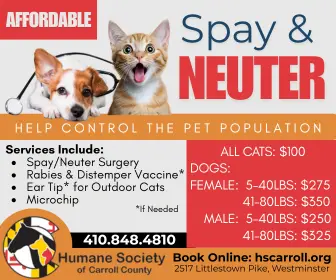Master Deputy Logan Helwig and K9 Dax (Above)
by Lisa Gregory, photography by Nikola Tzenov
Not Just A Dog
An older adult woman with dementia had gone missing. She had wandered out into the night in sub-zero temperatures wearing only a nightgown.
“Dax and I had only been out as a certified canine team for about two to three months,” says Master Deputy Logan Helwig of the Carroll County Sheriff’s Office’s K9 unit. “We knew we had to find her.”
Dax tracked the woman for 20 to 30 minutes before eventually leading officers to a cul-de-sac, where they found her standing on someone’s porch. “As Dax was walking directly up to that house, we got a call on the radio that the woman of the home had called 911, reporting that the lady was standing on her porch,” says Helwig. “Dax was going right to her.”
The incident was a good beginning to a relationship between officer and canine that’s thriving three years later.
“These dogs are invaluable to what we do,” says Sheriff Jim DeWees, a self-proclaimed dog lover who has seven dogs at home. “It takes a special person to put a dog in their car day in and day out and go to work with them and train them and get them to a point where they can be used for police work.”
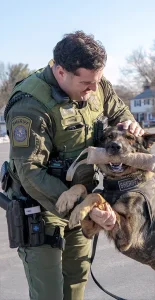
Besides Dax, a German shepherd from Hungary, the six dogs that make up the K9 unit include Kane, a chocolate lab from Washington state; Rom, a Belgian Malinois from Poland; Jet, a black lab from Germany; Finn, a yellow lab from Washington state; and Lazar, a German shepherd from Hungary. The dogs have a variety of skills and responsibilities, from tracking for narcotics detection to explosives and firearm detection.
Canines are way ahead of their human counterparts when it comes to their sense of smell, says Lt. Dustin Boone, K9 administrator. “You walk into a pizza place. You smell pizza,” he says. “Well, a dog can smell what type of dough is made in that pizza down to the human who prepared the crust.”
That strong sense of smell is an invaluable asset for law enforcement. “When you have a missing individual, the dog is given an article of clothing to smell,” says Boone. “The handler says the command and the dog will start from the last known point and will track the odor of the human. And they will track it for miles and miles.”
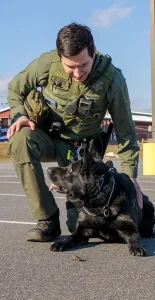
Becoming a handler for the K9 unit can be a challenging process. One must focus on the well-being of the dog as much as the human partner. For example, the handler agility test involves carrying a 75- to 80-pound sandbag to simulate a canine while running the obstacle course. “If something happens to your furry partner, you need to be able to pick them up, move them, get them somewhere safe,” says Boone.
The bond between the deputy and the dog is strong. “The stronger the bond, the better the team,” says Boone. “You are spending a 12-hour shift with that canine several days a week. You are with that dog more than your family.”
Deputy Brendan Black, who is partnered with Jet, was eager to take on the task. He says he wanted to be a K9 handler all his life, as his father and grandfather were both canine officers.
“My father’s dog was named Max, a German shepherd, and I was very close to Max growing up,” says Black. “I was always on top of him, playing with him, and then seeing him and my father go to work and do their job.”
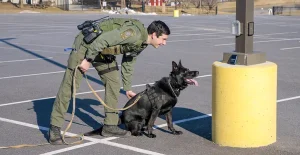
During a recent shift, Jet sat in the back seat of Black’s patrol car with his favorite toy, a stuffed teddy bear. During the shift, Jet sometimes rested his head against Black’s arm in a subtle gesture of affection. But when Black climbed out of his vehicle during a traffic stop, Jet’s body became rigid, his gaze was laser-focused on Black as he approached the car.
The vehicle in the traffic stop required searching for illegal drugs, and that’s when Jet went to work. He jumped out of the patrol car at Black’s command and alerted Black to the fact that he smelled illegal drugs.
With his job done, Jet returned to his seat in the patrol car. But his body remained tense, and his eyes followed Black as he and other police officers searched the vehicle. Later in the day, Jet was rewarded for his efforts with some downtime. A break for these two included fetching a ball to blow off steam. It’s important for both to step away briefly from the intensity of their work and just enjoy each other’s company.
The sheriff’s department carefully chooses dogs like Jet, who come from a “canine breeder for law enforcement and the military,” says Boone. “We’re not just going out there getting someone that had puppies and picking out a puppy and training it. They start training at a very young age — a couple months old, to gear them toward law enforcement or military work.
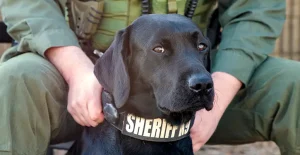
“We give them the guidelines — what we are looking for and what we need,” says Boone. The master trainer then contacts canine vendors in the United States and overseas. Many of the dogs are taught commands in different languages. This proves helpful in preventing someone besides the handler from calling out a command and confusing the dog, Boone adds.
Carroll County’s K9 unit works with Iron Rose K9 of Boiling Springs, Pennsylvania, for “maintenance training.” Boone says the dogs get eight hours of training two times a month, which means the dogs and their handlers get 16 hours of training each month to maintain their national certification in areas like narcotics, explosives and firearms detection.
Then there is the training during off hours. “We can drive our loved ones crazy,” says Cpl. Shawn Ullrich, a patrol supervisor who is partnered with Lazar. “They’re trying to cook dinner and we’re like, ‘I need to go hammer out some training in the backyard real quick.’”
During a recent training exercise, Lazar, the unit’s only patrol or bite dog, worked on his bite commands. Deputy Maxwell Chassange, a member of the K9 unit partnered with Kane, played the decoy in the exercise. Wearing a thickly padded bite suit, he was the target for Lazar. Despite the bite suit, Chassange admitted he can still end up with bruises following a training session.
Lazar, always aware of his handler, even while preparing to attack the target, attempted to place himself in front of his handler, Ullrich. “He wants to defend me as much as he wants to attack the decoy,” Ullrich told the trainer.
As Lazar latched on to the decoy, Chassange responded by groaning in pain. This response is the dog’s reward. Deputy Kyle Hessler explained that “the bite isn’t the objective.” The intimidation and the possibility of a bite is.
“It’s a controlled use of force,” says Boone.
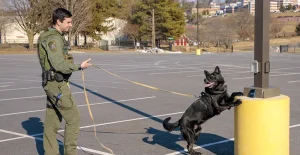
“A dog like Lazar gets a bite maybe twice in a career,” adds Hessler, who is partnered with Finn, the most recent addition to the K9 unit and the only one trained to detect explosive compounds.
Dogs for the K9 unit cost between $14,000 and $16,000. The Sheriff’s Office covers the costs for veterinarian visits, kenneling (if needed), food, and the K9 vehicle. The department also relies on community support and donations for other needs, such as bulletproof vests for the dogs.
Airpark Animal Hospital in Westminster, which provides veterinary care for the K9 unit dogs, recently donated $12,000 to the program with proceeds from a T-shirt fundraiser. “If it wasn’t for our community and their generosity, we wouldn’t be as successful as we are,” says DeWees.
Whether from the sheriff’s budget or the kindness of the community, it is all money well spent. Last year, for example, the K9 unit recovered approximately $60,000 in illegal drugs and controlled substances.

“The amount of drugs that our dogs have assisted in seizing and getting off of the streets has dramatically impacted the level of overdoses that we’ve had in the county,” says Helwig. “Hundreds of lives have been saved when it comes to fentanyl overdoses and everything else.”
But it is not all work. The dogs live at home with their respective handlers and are considered a part of the family. They are different dogs when not on duty. “Oh, my gosh, a lot of the time, you can find Jet on the couch or the bed feet straight up in the air on his back just sleeping,” says Black, adding with a chuckle, “Sometimes he falls off.”
However, when the uniform goes on, “he knows he is going to work,” says Black. And Black takes great comfort in having his partner in the seat behind him. “Jet is more than just a dog,” says Black. “He is my best friend. And I would protect him with everything I could.”
“Canines are way ahead of their human counterparts when it comes to their sense of smell. You walk into a pizza place. You smell pizza. Well, a dog can smell what type of dough is made in that pizza down to the human who prepared the crust.” – Lt. Dustin Boone, Carroll County Sheriff K9 Administrator


